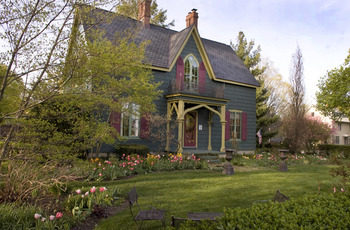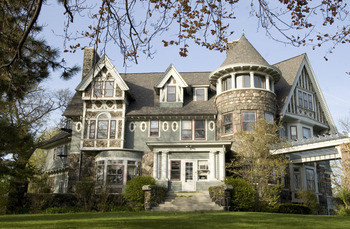Ypsilanti's East Side Neighborhood is steeped in history and stately homes

The Gilbert Mansion on Grove Street in Ypsilanti.
Angela Cesere | AnnArbor.com
Each time a locomotive rolled into Ypsilanti from Detroit during the mid-1860s, passengers regarded with awe a stunning, towering home on a hill overlooking the tracks.
The home, a grand, French second empire structure, features a mansard roof with a colorful floral pattern in its tiles, and a unique, square tower from which one can see for miles. It’s one of the more widely recognized homes in Ypsilanti, and it was a striking site for those coming to town via rail.
“It’s the local insane asylum,” the conductor would tell the passengers.
But the conductor, John Gilbert, wasn’t quite speaking literally, as the Gilbert Mansion was where he lived with his family. His father had made a fortune in lumber, and Gilbert worked on the Michigan Central Railroad as a conductor. In 1862, he built what is regarded as one of Ypsilanti’s most iconic homes.
The Gilbert Mansion is just one of many historic, well-maintained homes in the city’s historic East Side Neighborhood, which has a high concentration of such houses. Many of the homes bear the historic structure marker issued by the Ypsilanti Heritage Foundation. The signs are reserved for homeowners whose dwellings demonstrate a regard for authenticity and high degree of maintenance.
One of those houses, a green shingled and red shuttered Gothic home, is owned by Hank Prebys and Joe Mattimoe. Prebys and Mattimoe, the president and treasurer of the YHF, have lived in the house for 30 years. Like the Gilbert Mansion across the street and many other homes in the neighborhood, it has a unique story.
Benjamin Follett, who owned a three-story hotel in Depot Town, also owned a large piece of property with a Gothic-style building that was used as a school. Charles Woodard, a prominent area civil engineer, had the home moved to its current Grove Street location in 1860. Roughly 75 years later, it was sold to a prominent local builder, Fred Dieterle, who modernized it.
After the home changed hands again, Mattimoe discovered it on the market in 1979, and quickly moved to purchase it. Mattimoe and Prebys, who both worked part-time as assistants to an antique show promoter, carefully made over the yard, adding flowers, gardens and landscaping.
Indoors, their home is stuffed with antique pottery, furniture, and quirky collections of hands in the bathroom and snakes in the kitchen. The kitchen and bathroom received extensive updates, and the house was long a work in progress.
“It has always has been a refuge and a place that we thoroughly enjoy,” Prebys said. “It’s our house and it’s been fun putting together.”

The home of Hank Prebys and Joe Mattimoe in Ypsilanti's historic East Side Neighborhood.
Tom Perkins | For AnnArbor.com
“Over the space of 30 years, it’s just amazing to see what happened to the neighborhood,” Prebys says.
A strong community of preservationists has emerged in Ypsilanti centered around the city’s rich historical architecture.
“Ypsilanti is really a small town, and people are willing to participate,” Prebys explains. “As you begin to know your neighbors, you begin to be sensitized to things they are interested in, and there has been kind of a groundswell of interest in historic preservation.”
Critical to the area's transformation was its inclusion in the Historic District Commission’s historic district and a zoning change to single family residential.
In the historic East Side Neighborhood, there are roughly 30 marked historic homes and many more that haven’t yet received the YHF’s stamp. The large historic district includes both sides of the Huron River, is one of the largest in the state and, according to Prebys, has saved the core of the city from demolition.
Originally, the historic district only included the west side of the river. But a developer floated the idea of razing the East Side Neighborhood to make room for an industrial park, and several people quickly acted to save the neighborhood.
Around that time, the Heritage Foundation formed and spearheaded an effort to save the Towner House near Huron and Cross streets. Built in 1837, it’s the oldest structure on its original foundation in Ypsilanti, and the group was successful in saving it from becoming a church parking lot.
The east side was born out of the commerce boom that accompanied the new rail stop in Depot Town in the 1830s and was a mix of homes that accommodated the wealthy and workers. Prebys said it is much the same today - their own block includes professionals, retirees and young people. Michael Newberry, 24, and his wife, Joan, recently purchased a house at the corner of Grove and Cross Streets. The 119-year-old home came with a historic structure marker and a price tag of only $85,000.
Newberry, who works as a preservationist, was naturally attracted to the neighborhood, but said it also fit the couple’s budget.
“I have always liked this area,” said Newberry, who moved to Ypsilanti from Ann Arbor. “The historic East Side and Normal Park neighborhoods are the two that stood out as the most stable and historic in the city. It’s a charming little home and we got to skip the starter house phase. While it’s got a lot of work that needs to be done, I feel like we won.”
The largest of the neighborhood’s houses are no longer occupied by one family. The Gilbert Mansion now has seven apartments, while the biggest home in the city, the Hutchinson Mansion at 1616 North River St., is now home to an educational service company.
Among the 30 rooms in the Hutchinson Mansion were a ballroom, indoor swimming pool, billiard room, marble fireplaces and five bathrooms. The home is a blend of Tudor-revival, craftsman and Queen Anne architecture, and was built in 1904 for the bride of Shelly Byron Hutchinson. The name Hutchinson was the “H” half of S&H Green Stamps.

The Hutchinson Mansion
Tom Perkins | For AnnArbor.com
But Prebys said no bride ever took up residence and Hutchinson took up a life of “wine, women and song.” The home was quickly sold in 1912.
Across the street, the more modest but no less interesting Swaine House was built for malt mogul Frederick Swaine’s bride in 1870. His bride did move into the Italianate wing-and-gable home. The family prospered there, where Swaine’s daughters remained until both had passed away by 1968.
Robert and Janice Anschuetz purchased the home around that time. Two feet of water had filled the basement, there were no electrical outlets and it still had its original furnace.
The Anschuetzes also bought all the furniture, which included a Chickering grand Piano from 1873. Swaine was dubbed “The Father of Classical Music” by Fred Pease for his help in developing the Michigan State Normal School’s music program. After years of searching for someone who could perform the work, the Anschuetzes were finally able to have the piano restored to good condition.
Janice Anschuetz said she and her husband purchased the house because they like the challenge that came with it and didn’t want to see the home torn down.
“I liked recycling before it was popular,” she said.


Comments
Ryan Daly
Mon, Feb 4, 2013 : 12:14 a.m.
Thanks for the article, it inspired me to go on my own "Ypsi Architecture Tour!"
Josh Budde
Thu, Jul 1, 2010 : 12:47 p.m.
As someone that lives in a historic home in Ypsi, I'm very happy to see an article like this on AnnArbor.com. Ypsilanti has incredibly rich history that is sadly overlooked these days. For a fascinating view of what Ypsi looked like in the late 1800s this map may prove illuminating: http://memory.loc.gov/cgi-bin/map_item.pl?data=/home/www/data/gmd/gmd411/g4114/g4114y/pm003800.sid&style=pmmap&itemLink=r?ammem/gmd:@filreq(@field(NUMBER+@band(g4114y+pm003800))+@field(COLLID+pmmap))&title=Ypsilanti,%20Washtenaw%20Co.,%20Michigan.%20Drawn%20%26%20published%20by%20A.%20Ruger.
RhondaM
Wed, Jun 30, 2010 : 1:20 a.m.
Thank You for posting this!!! I lived in Ypsi for 2 yrs in a not so great neighborhood. But I loved walking and driving around to see the hidden gems of Ypsi. Ypsi is not as bad as Us Ann Arbor Townies think.
eanschuetz
Tue, Jun 29, 2010 : 6:50 p.m.
Very nice article! The east side of Ypsilanti is really a hidden gem. As a child, I was lucky to spend a lot of time in the Gilbert house when it served as the Boys' Club. I grew up across the street from the Hutchinson house (Casa Loma). I am proud to say that I lived in the Swaine house for 18 years which was lovingly restored by my parents.
Mary S.
Mon, Jun 28, 2010 : 2:53 p.m.
I grew up in Ypsi, not far from Wiard's Orchard. I remember the wonderful homes int he pictures, and then some. You just made me severely homesick, but it was worth it. Thank you.
CountyKate
Mon, Jun 28, 2010 : 9:38 a.m.
I would love to see more stories like this. The histories of some homes in Ypsilanti are truly fascinating.
tanya
Sun, Jun 27, 2010 : 2:33 p.m.
Thank You for taking the time to share with your readers some of my fave homes in Ypsilanti! My family and I take regular drives through the neighborhoods and try to decide which mansion we should be living in.;)